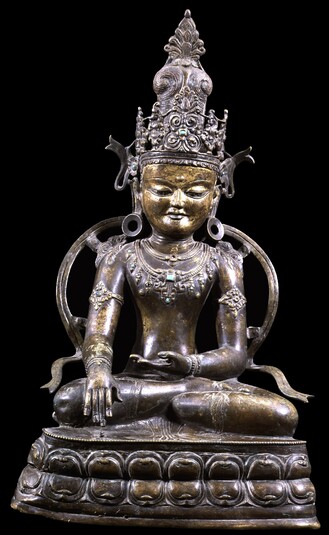
Item: Akshobhya Buddha - (Peaceful Appearance)
| Origin Location | Tibet |
|---|---|
| Date Range | 1200 - 1299 |
| Lineages | Buddhist |
| Size | 45.09cm (17.75in) high |
| Material | Bronze |
| Collection | Rubin Museum of Art |
| Catalogue # | acc. #C2002.47.3 |
Classification: Deity
Akshobhya, Buddha (Tibetan: mi kyu pa, sang gye): a principal buddha within Vajrayana Buddhism residing in the eastern quarter of a mandala and a minor buddha within the sutra tradition of Mahayana Buddhism.
"Arising in the eastern direction is Akshobhya on an elephant, lotus and moon throne; with a body blue in colour the right hand is placed in the mudra of pressing down." (Dragpa Gyaltsen, 1147-1216).
Occupying a central role in Vajrayana Buddhism, Akshobhya, by some accounts, is Lord of the 2nd of the Five Buddha Families of tantra and found throughout all 4 tantra classifications most notably in the anuttarayoga class. Akshobhya is also mentioned in several Mahayana sutras, the Vimalakirti Nirdesa being the most famous. It was in Abhirati, the pureland of Akshobhya, attainable only by 8th level bodhisattvas, where the famous Tibetan yogi Milarepa and the scholar Sakya Pandita are said to have obtained complete buddhahood.
Jeff Watt 9-99
Collection of Rubin Museum of Art: Sculpture (Gallery 1)
Buddhist Deity: Akshobhya Buddha Main Page (阿閦佛)
Sculpture: Monastic Period (Tibet, 13-14th century)
Sculpture: Monastic Period (Sambhogakaya Buddha)

